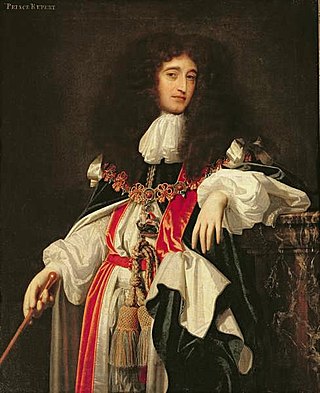莱茵河的鲁珀特亲王
来自维基百科,自由的百科全书
普法尔茨的鲁珀特亲王,KG,PC,FRS(英语:Prince Rupert of the Rhine, Duke of Cumberland;1619年12月17日(旧历)/ 12月27日(新历)[1]—1682年11月29日)神圣罗马帝国内称莱茵河王权伯爵鲁普雷希特(德语:Ruprecht Pfalzgraf bei Rhein, Herzog von Bayern),是德意志和英格兰陆军军官、海军上将、科学家和殖民地总督。他在英格兰内战期间以保王党骑兵指挥官的身份首次崭露头角。鲁珀特是普法尔茨选侯弗里德里希五世和苏格兰及英格兰国王詹姆士六世及一世的长女伊丽莎白·斯图亚特第三子。
鲁珀特亲王的职业生涯丰富多彩。他幼年从军,在八十年战争(1568年—1648年)中与荷兰军队一起对抗西班牙哈布斯堡王朝,在三十年战争(1618年—1648年)中与德意志的神圣罗马皇帝作战。23岁时,他在英格兰内战期间受任命为保王党骑兵指挥官,成为这场战争中典型的“骑士”(Cavalier),最终成为保王党高级将领。他在布里斯托尔沦陷后投降,并被驱逐出英格兰。他在法兰西国王路易十四的统治下对抗西班牙,然后在加勒比海做保王党私掠船船长。王政复辟后,鲁珀特回到英格兰,在第二次英荷战争和第三次英荷战争中担任英格兰海军高级指挥官,并担任哈德逊湾公司首任总督。他于1682年在英格兰去世,享年62岁。
鲁珀特被视为思维敏捷、精力充沛的骑兵将领,但他在内战期间与同僚打交道时缺乏耐心,这最终削弱了他的优势。在王政复辟时期,鲁珀特从地中海到加勒比海继续在海上与议会发生冲突,面对逆境表现出相当的毅力。晚年担任王家海军司令员,表现得更加成熟,对王家海军的学说和发展做出了令人印象深刻和持久的贡献。身为殖民地总督,鲁珀特塑造了现代加拿大的政治地理:鲁珀特地以他的名字命名,他是哈德逊湾公司的创始人。他还受指控参与了早期的大西洋奴隶贸易。鲁伯特在科学和行政方面的各种兴趣,加上他高超的艺术技巧,使他成为斯图亚特王朝复辟时期英格兰最引人注目的公众人物之一。
早年生活及流亡

1619年,三十年战争开始时,鲁珀特出生于 波希米亚选侯国布拉格,双亲分别是普法尔茨选侯兼波希米亚选侯弗里德里希五世和伊丽莎白·斯图亚特。卢萨蒂亚侯国宣布鲁珀特为亲王[2]。他的名字是为了纪念维特尔斯巴赫王朝著名的祖先德意志国王鲁普雷希特[3]。鲁珀特的父亲是神圣罗马帝国领导成员,也是新教联盟首领,家族尚武的传统可以追溯到几个世纪以前[4]。鲁珀特的家族是整个北欧新教统治者网络的核心,因为弗里德里希通过他的母亲与联省统治者奥朗日-拿骚公室关系密切,伊丽莎白是英格兰国王詹姆斯一世和丹麦的安妮之女。这家人在海德堡过着极其富裕的生活,享受着由伊尼戈·琼斯和萨洛蒙·德·考斯设计的宫殿花园王权花园,还有一座拥有欧洲最好图书馆之一的豪华城堡[5]。
1619年,弗里德里希与反叛的信奉新教的波希米亚贵族结盟,希望新教联盟支持他反抗新当选的神圣罗马皇帝信奉天主教的费迪南德二世[6]。弗里德里希并未得到支持,导致他在1620年的白山战役中惨败于天主教敌人手中。鲁珀特的父母在波希米亚的统治只维持了一季,被戏称为“冬王和冬王后”[7]。为了躲避费迪南德突袭布拉格,鲁珀特几乎被抛在了后面,直到宫廷成员克里斯托弗·多纳(Kryštof z Donína)在最后一刻把亲王扔上了马车[8]。
鲁珀特陪同他的双亲来到海牙,在海牙的瓦森纳宫廷(Hof te Wassenaer)度过了他的早年时光[9]。即使按照当时的标准,鲁珀特的母亲也很少关心她的孩子,显然更喜欢她的宠物猴和狗[10]。相反,弗里德里希聘请德普勒森(de Plessen)先生和夫人管理他的孩子,指示他们谆谆教诲孩子要对捷克人/波西米亚人和英格兰持正面态度,并把孩子培养成严格的加尔文宗信徒[10] 。结果是严格的日常教学,包括逻辑、数学、写作、绘画、歌唱和演奏乐器[10]。孩提之童时,鲁珀特有时表现不好,“暴躁、淘气、易怒”,有“恶魔鲁珀特”(Robert le Diable)的绰号[11]。尽管如此,鲁珀特被证明是个很有能力的学生。三岁时,他能说一些英语、捷克语和法语,还小时就掌握了德语,但对拉丁语和希腊语不感兴趣[10]。杰拉德·凡·洪特霍斯特教他艺术,他擅长艺术,发现数学和科学很容易[10]。18岁时,他身高约6英尺4英寸(1.93米)[12]。
鲁珀特的家庭在海牙期间继续试图夺回王权选区。资金短缺,他的家庭依靠来自海牙相对较少的津贴,家庭投资荷兰突袭西班牙船舶的收益,以及典当家庭珠宝的收益[13]。弗里德里希开始说服包括英格兰、法兰西和瑞典在内的国家联盟支持他夺回王权选区和波希米亚的企图[11]。到17世纪30年代初,弗里德里希与德意志的主要新教领袖瑞典国王古斯塔夫二世·阿道夫建立了密切的关系。然而,在1632年,古斯塔夫·阿道夫坚持要求弗里德里希在收回土地后给予信奉路德宗和加尔文宗的臣民平等权利,两人在此问题上存在分歧;弗里德里希拒绝了,并开始返回海牙。他在路上死于发烧,被埋在一个无名的坟墓里[14]。鲁珀特在13岁时失去了父亲,而古斯塔夫·阿道夫同月在吕岑会战中阵亡,使家庭失去了一个重要的新教盟友[15]。弗里德里希去世后,国王查尔斯提议全家搬到英格兰;鲁珀特的母亲拒绝了,但请求查尔斯将他的保护延伸到她剩下的孩子身上[16]。
家庭
| 先祖 | ||||||||||||||||||||||||||||||||||||||||||||||||||||||||||||||||||||||||||||||||||||||||||||||||||||||||||||||||||||||||||||||||||||||||||||||||||||||||||||||||||||||||||||||||||||||||||||||||||||||||||||||||||||||||||||||||||||||||||||||||||||||||||||||||||||||||||||||||||||||||||||||||||||||||||||||||||||||||||||||||||||||||||||||||||||||||||||||||||||||||||||||||||||||||||||||||||||||||||||||||||||||||||||||||||||||||||||||||||||||||||||||||||||||||||||||||||||||||||||||||||||||||||||||||||||||||||||||||||
|---|---|---|---|---|---|---|---|---|---|---|---|---|---|---|---|---|---|---|---|---|---|---|---|---|---|---|---|---|---|---|---|---|---|---|---|---|---|---|---|---|---|---|---|---|---|---|---|---|---|---|---|---|---|---|---|---|---|---|---|---|---|---|---|---|---|---|---|---|---|---|---|---|---|---|---|---|---|---|---|---|---|---|---|---|---|---|---|---|---|---|---|---|---|---|---|---|---|---|---|---|---|---|---|---|---|---|---|---|---|---|---|---|---|---|---|---|---|---|---|---|---|---|---|---|---|---|---|---|---|---|---|---|---|---|---|---|---|---|---|---|---|---|---|---|---|---|---|---|---|---|---|---|---|---|---|---|---|---|---|---|---|---|---|---|---|---|---|---|---|---|---|---|---|---|---|---|---|---|---|---|---|---|---|---|---|---|---|---|---|---|---|---|---|---|---|---|---|---|---|---|---|---|---|---|---|---|---|---|---|---|---|---|---|---|---|---|---|---|---|---|---|---|---|---|---|---|---|---|---|---|---|---|---|---|---|---|---|---|---|---|---|---|---|---|---|---|---|---|---|---|---|---|---|---|---|---|---|---|---|---|---|---|---|---|---|---|---|---|---|---|---|---|---|---|---|---|---|---|---|---|---|---|---|---|---|---|---|---|---|---|---|---|---|---|---|---|---|---|---|---|---|---|---|---|---|---|---|---|---|---|---|---|---|---|---|---|---|---|---|---|---|---|---|---|---|---|---|---|---|---|---|---|---|---|---|---|---|---|---|---|---|---|---|---|---|---|---|---|---|---|---|---|---|---|---|---|---|---|---|---|---|---|---|---|---|---|---|---|---|---|---|---|---|---|---|---|---|---|---|---|---|---|---|---|---|---|---|---|---|---|---|---|---|---|---|---|---|---|---|---|---|---|---|---|---|---|---|---|---|---|---|---|---|---|---|---|---|---|---|---|---|---|---|---|---|---|---|---|---|---|---|---|---|---|---|---|---|---|---|---|---|---|---|---|---|---|---|---|---|---|---|---|---|---|---|---|---|---|---|---|---|---|---|---|---|---|---|---|---|---|---|---|---|---|---|---|---|---|---|---|---|---|---|---|---|---|---|---|---|---|---|---|---|---|---|---|---|---|---|---|---|---|---|---|---|---|---|---|---|---|---|---|---|---|
| ||||||||||||||||||||||||||||||||||||||||||||||||||||||||||||||||||||||||||||||||||||||||||||||||||||||||||||||||||||||||||||||||||||||||||||||||||||||||||||||||||||||||||||||||||||||||||||||||||||||||||||||||||||||||||||||||||||||||||||||||||||||||||||||||||||||||||||||||||||||||||||||||||||||||||||||||||||||||||||||||||||||||||||||||||||||||||||||||||||||||||||||||||||||||||||||||||||||||||||||||||||||||||||||||||||||||||||||||||||||||||||||||||||||||||||||||||||||||||||||||||||||||||||||||||||||||||||||||||
引用
参考文献
外部链接
Wikiwand - on
Seamless Wikipedia browsing. On steroids.

